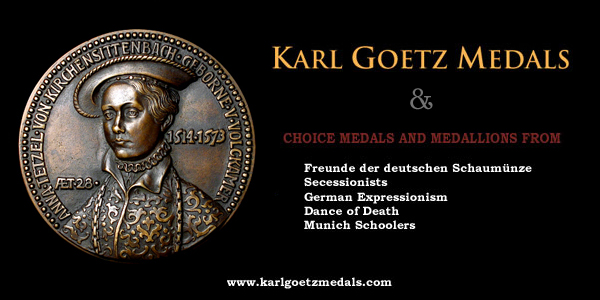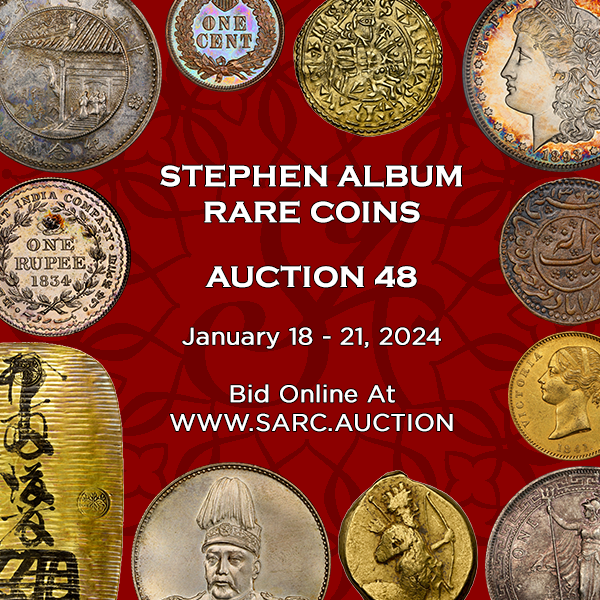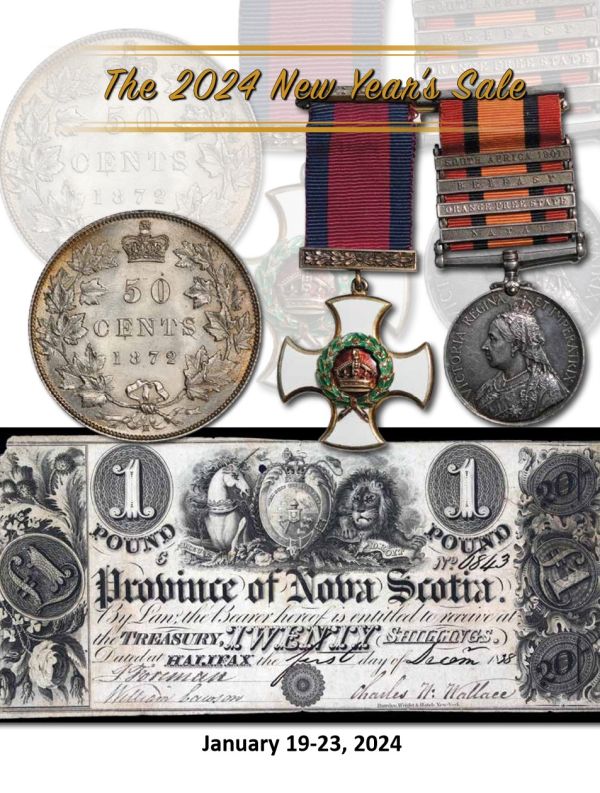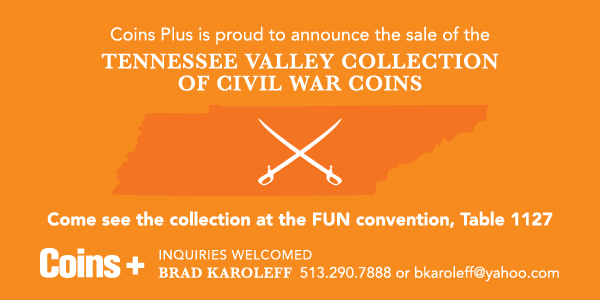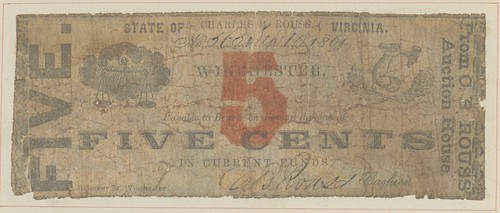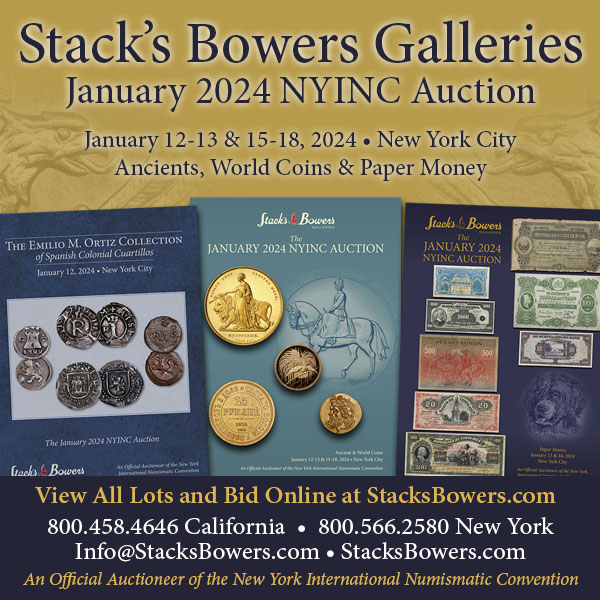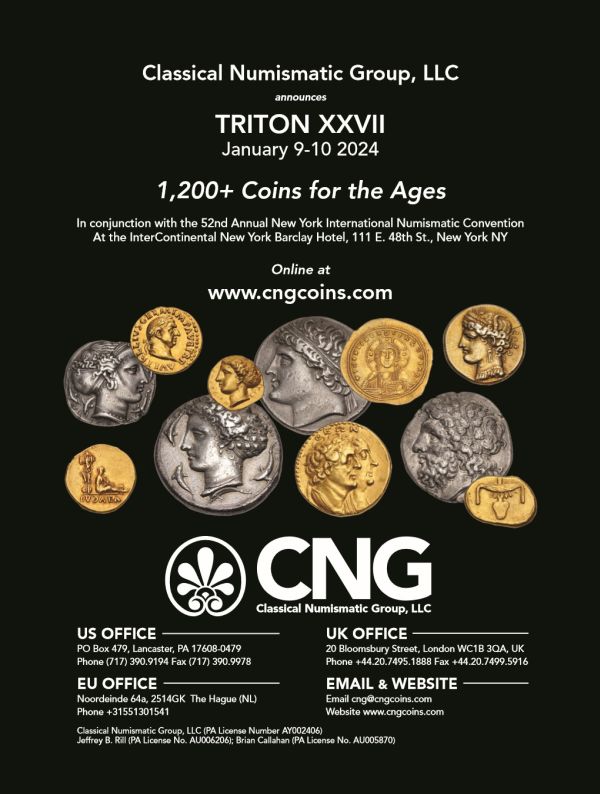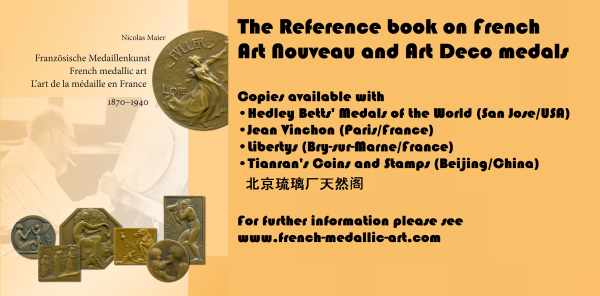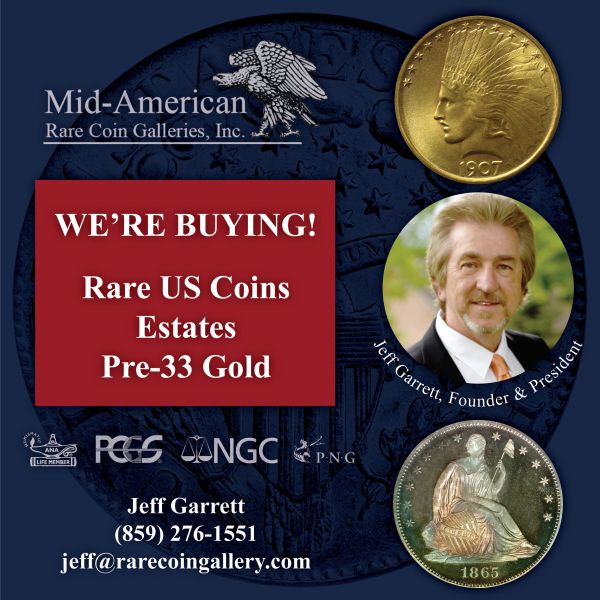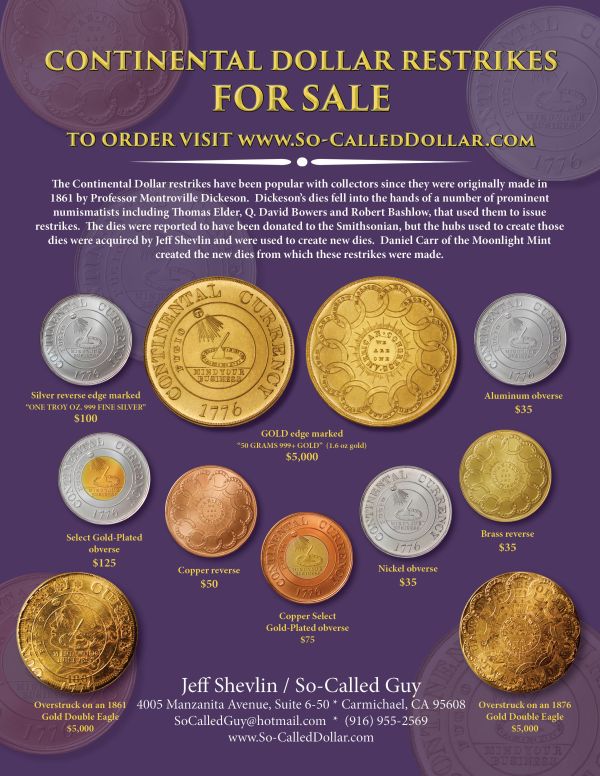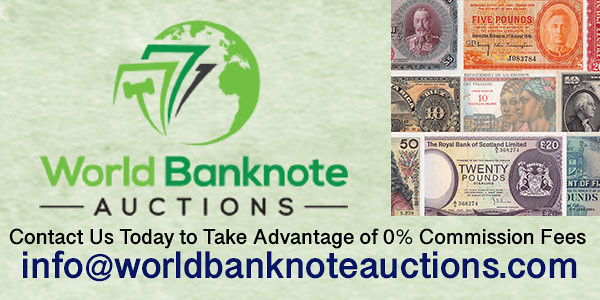
Visit our NBS Sponsors




About UsThe Numismatic Bibliomania Society is a non-profit association devoted to the study and enjoyment of numismatic literature. For more information please see our web site at coinbooks.org SubscriptionsThose wishing to become new E-Sylum subscribers (or wishing to Unsubscribe) can go to the following web page link MembershipThere is a membership application available on the web site Membership Application To join, print the application and return it with your check to the address printed on the application. Print/Digital membership is $40 to addresses in the U.S., and $60 elsewhere. A digital-only membership is available for $25. For those without web access, write to: Jeff Dickerson, Treasurer AsylumFor Asylum mailing address changes and other membership questions, contact Jeff at this email address: treasurer@coinbooks.org SubmissionsTo submit items for publication in The E-Sylum, write to the Editor at this address: whomren@gmail.com BUY THE BOOK BEFORE THE COIN |
- WAYNE'S WORDS: THE E-SYLUM JANUARY 7, 2024
- KOLBE & FANNING BUY OR BID SALE NUMBER 23
- NEW BOOK: SPECIAL SERIAL NUMBERED BANKNOTES
- NEW BOOK: MONEY BOXES
- ANS PUBLICATION CATALOG PUBLISHED
- HAPPY NEW YEAR NUMISMATIC TOKENS
- VIDEO: LARRY WILSON INTERVIEW
- MORE ON JOHN BURNHAM
- UNSOLVED NUMISMATIC PUZZLES FROM DUBLIN
- NOTES FROM E-SYLUM READERS: JANUARY 7, 2024
- BLIND COIN COLLECTOR UPDATE
- THE VERMONT POUND THEORY
- DEAL RESCUES STANLEY GIBBONS AND BALDWIN'S
- VOCABULARY TERM: OXIDATION
- UPDATE: KKK TOKENS AUTHOR DALE BIRDSELL
- TOM CALDWELL INTERVIEW, PART TWO
- TIBET MUSEUM'S NUMISMATIC EXHIBIT
- KüNKER SALE 400 HIGHLIGHTS
- NUMISMATIC NUGGETS: JANUARY 7, 2024
- THE COIN THAT SHOULDN'T EXIST
- LINCOLN CENT MULED WITH A ROOSEVELT DIME
- AUSTRALIA MINTS WORLD'S 1ST COIN IN 2024
- HARRIET TUBMAN COMMEMORATIVE COINS
- TAMPA'S BREADCOIN TOKENS
- THE INIMITABLE NOTE COMPETITION
- THE JAMES W. FERRY TRAVEL NOTE
- CRAFTY COUNTERFEIT DISPLAY, PART ONE
- LOOSE CHANGE: JANUARY 7, 2024
- FEATURED WEBSITE: COIN OF NOTE
Content presented in The E-Sylum is not necessarily researched or independently fact-checked, and views expressed do not necessarily represent those of the Numismatic Bibliomania Society.
WAYNE'S WORDS: THE E-SYLUM JANUARY 7, 2024
 New subscribers this week include:
Jackie Wesche-Thobaben and Ryan Spak
of the Western Pennsylvania Numismatic Society, courtesy Ed Krivoniak;
Emma Hulme of Sovereign Rarities Ltd, courtesy Steve Hill;
Welcome aboard! We now have 7,646 subscribers.
New subscribers this week include:
Jackie Wesche-Thobaben and Ryan Spak
of the Western Pennsylvania Numismatic Society, courtesy Ed Krivoniak;
Emma Hulme of Sovereign Rarities Ltd, courtesy Steve Hill;
Welcome aboard! We now have 7,646 subscribers.
Thank you for reading The E-Sylum. If you enjoy it, please send me the email addresses of friends you think may enjoy it as well and I'll send them a subscription. Contact me at whomren@gmail.com anytime regarding your subscription, or questions, comments or suggestions about our content.
This week we open with a numismatic literature sale, two new books, updates from the Newman Numismatic Portal, notes from readers, and more.
Other topics this week include unsolved numismatic puzzles, the "Vermont Pound", Baldwin's, Dale Birdsell, Tom Caldwell, the first coin minted in 2024, the Tubman commemoratives, Breadcoins, and the Inimitable Note competition.
To learn more about special serial numbers, coin banks, Toltec scraper money, the South Carolina SPCA medal, gradeflation, the 1819 George Cruikshank Bank Restriction note, the 1820 George III Pattern 5 pounds, the Society of Music Friends medal, and the coins that shouldn't exist, read on. Have a great week, everyone!
Wayne Homren
Editor, The E-Sylum
KOLBE & FANNING BUY OR BID SALE NUMBER 23
Numismatic Booksellers Kolbe & Fanning submitted this announcement of their 23rd "Buy or Bid Sale" which closes on January 16, 2024. Good luck, everyone! -Editor
 Kolbe & Fanning Numismatic Booksellers have announced our latest “Buy or Bid Sale,” which begins now and will close on Tuesday, January 16, 2024. With hundreds of new additions, the sale focuses on modestly priced books, giving collectors an opportunity to add to their libraries at minimal cost.
Kolbe & Fanning Numismatic Booksellers have announced our latest “Buy or Bid Sale,” which begins now and will close on Tuesday, January 16, 2024. With hundreds of new additions, the sale focuses on modestly priced books, giving collectors an opportunity to add to their libraries at minimal cost.
The sale includes over 1200 works on ancient, medieval and modern coins, as well as general works, periodicals and sale catalogues. “Buy” prices have been kept low to promote sales. To further encourage participation, the firm is offering free domestic shipping to bidders spending at least $300; there is also no packing and processing fee for this sale. Again, please read the Terms of Sale before participating.
As the name of the sale suggests, customers may bid on items they wish to acquire or buy them outright at the published price. The Terms of Sale will give full instructions on how to participate: please read it carefully.
THE BOOK BAZARRE
NEW BOOK: SPECIAL SERIAL NUMBERED BANKNOTES
With permission we're republishing this article from the January 2024 issue of The Mint Master from the Utah Numismatic Society by Editor/Publisher Doug Nyholm, about a new book on a specialized paper money topic by Mike Abramson. Thanks! -Editor
 This new book by Mike Abramson just arrived a
few days before Christmas to my mailbox. It may
not be for everyone but for me it is a significant
work on a subject that has never been written about
before except for in auction catalogues where these
notes have appeared.
This new book by Mike Abramson just arrived a
few days before Christmas to my mailbox. It may
not be for everyone but for me it is a significant
work on a subject that has never been written about
before except for in auction catalogues where these
notes have appeared.
Mike stated that all of the notes illustrated in this book are ones that he has owned, handled, brokered, or sold except for just 5 of them. The combined value of these notes exceeds $40 million dollars.
So what is a serial number? Plenty! If you are lucky enough to acquire one which is almost impossible, even looking for a low s/n amongst all the notes that pass through your hands is extremely unlikely. I look through all the notes in my wallet and from circulation have never found one with more than 4 leading zeros. Or to be exact one with a serial number around 2000. Other notes that may occasionally be found are radars or repeaters such as 23455234 or 45604560 but even these are rare.
Once while on a buying trip a customer came in with a $10 S/n 77777777 which his wife received from their bank. I was amazed and immediately purchased it. Generally these notes are acquired by people who work at facilities that handle vast sums of banknotes and keep their eyes open but the exact nature of their operations are a subject for an extensive article.
NEW BOOK: MONEY BOXES
From Budapest Dave Hirt writes:
 "My numismatic friend Balazs
gave me three new books for Christmas. I want to report on one of them. The text is in two languages, Hungarian and English. The English title is Coin Boxes (small saving banks). The Hungarian title is PERSELYEK.
It is written by Andras Szlanka, the curator of the OTP Bank' s History of Finance Collection.
"My numismatic friend Balazs
gave me three new books for Christmas. I want to report on one of them. The text is in two languages, Hungarian and English. The English title is Coin Boxes (small saving banks). The Hungarian title is PERSELYEK.
It is written by Andras Szlanka, the curator of the OTP Bank' s History of Finance Collection.
"The book has over 300 pages, each one having an illustration of a bank. I had not given any thought to the connection of these banks to coin collecting. I believe that many numismatists, including myself, got their start saving coins, when getting a present of a small bank, perhaps with a few coins to start their savings...
"There are amazing and artistic differences, starting with silver banks from the 19th century, brass, copper, medal, ceramic, cardboard, paper, etc. There is a whole section on piggy banks. The illustrations are quite interesting."
ANS PUBLICATION CATALOG PUBLISHED
In an email to members this week, the American Numismatic Society announced a new distribution partnership for its publications. -Editor
The American Numismatic Society proudly partners with ISD for the distribution of our publications to customers in the United States. ISD has just released a special catalogue of new, recent, and backlist numismatic titles that they distribute, highlighting those from the ANS and from other publishers of numismatic literature.
Don't forget—ANS members in the US receive a 30% discount on ANS publications from ISD using [a membership] code
HAPPY NEW YEAR NUMISMATIC TOKENS
Newman Numismatic Portal Project Coordinator Len Augsburger provided this report. Happy New Year! -Editor
 HAPPY NEW YEAR NUMISMATIC TOKENS
HAPPY NEW YEAR NUMISMATIC TOKENS
One of the most frequently accessed references on Newman Portal is Pete Smith’s Personal Tokens and Medals of American Numismatists, published in 2020. The popularity of certain documents on the Internet is sometimes somewhat of a mystery, but we’ve noticed that works that refer to many individual persons tend to run “hot.” This volume has been accessed 8,386 times, indicating daily use by multiple people.
HAPPY NEW YEAR is a common theme on numismatic tokens. Indeed, of the approximately 8,000 tokens, medals and woods cataloged in Pete Smith’s work, nearly 600 feature the inscription HAPPY NEW YEAR. Issuing dealers include Dottie Dow, Doug Fairbanks, Al & Sally Kirka, and a host of others.
VIDEO: LARRY WILSON INTERVIEW
The David Lisot Video Library on the Newman Numismatic Portal can be found at:
https://nnp.wustl.edu/library/multimediadetail/522852
We highlight one of his videos each week in The E-Sylum. Here's one from 1985 with Colorado collector Larry Wilson. -Editor
Collector Larry Wilson talks Toltec scraper money, Aztec copper hoe money, Indian Peace Medals, guitars and more!
The segment begins around the 11:25 mark, following an odd musical cartoon public service commercial from the U.S.D.A and H.H.S. about salt and sodium. -Editor
MORE ON JOHN BURNHAM
Numismatic bookseller and NBS co-founder George Kolbe submitted these notes on the late John Burnham. Thank you. -Editor
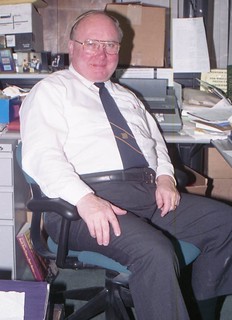 As previously attested in the E-Sylum, John Burnham loved books, and that extended to the numismatic variety. We likely met at a New York coin convention in the early 1980s. I often stayed at the Salisbury Hotel, adjacent to Stack’s retail store on 57th Street. Its glory a bit faded, the Salisbury nonetheless had a certain charm, considerably enhanced by reasonable room rates.
As previously attested in the E-Sylum, John Burnham loved books, and that extended to the numismatic variety. We likely met at a New York coin convention in the early 1980s. I often stayed at the Salisbury Hotel, adjacent to Stack’s retail store on 57th Street. Its glory a bit faded, the Salisbury nonetheless had a certain charm, considerably enhanced by reasonable room rates.
John and I hit it off almost immediately – despite our different backgrounds, we were simpático. A consultant to Stack’s Coin Galleries, John regularly spent a night or two each week at the Salisbury. Early on, I remember securing a bottle of Johnny Walker Red and enjoying an evening with John at the Salisbury, bravely solving the world’s political and cultural problems. Other memories abound.
In the mid 90s, I travelled to Orlando, Florida to acquire the numismatic library on ancient coins formed by Frederick Knobloch. John was there for the coins. The trip from the airport in the car of a female family member was a little unusual. A handgun graced the center console, which, she assured me, was locked and loaded, and always accompanied her. At the house, a shotgun resided behind the entry door. After successfully conducting our business deals, John and I spent another delightful evening, albeit this time in a dismal motel room, permeated with an inescapable eau de mildew.
UNSOLVED NUMISMATIC PUZZLES FROM DUBLIN
Gawain O'Connor writes:
"Perhaps your item about puzzles is not totally non-numismatic after all. The Hordern-Dalgety Collection of puzzles still has a website at https://www.puzzlemuseum.com/
"A couple items that I have wondered about for years are on their unsolved puzzles page: https://www.puzzlemuseum.com/month/picm02/200206dublin.htm
"I wonder if anyone has ever solved these. Perhaps modern deciphering techniques can help...
"Johnson was in business a hundred years ago, but I haven't found their successors, or anyone who might know something about the solution."
NOTES FROM E-SYLUM READERS: JANUARY 7, 2024
Charles Broadway Rouss of Winchester, VA
Eric Schena writes:
"That is a really neat book of notes; the one note from Winchester was issued by Charles Broadway Rouss who ran an auction house on Loudoun St. He later left and made his fortune in New York but bequeathed a considerable amount of money back to Winchester. City Hall is named after him, as is one of the bigger fire departments, plus numerous other things. Those are quite rare (the Jones-Littlefield catalog carries it as an R-7) and I have been looking for one for many years. Really a neat item!"
Agreed - I knew Eric would appreciate this note - he lives in Winchester and has collected Virginia scrip notes for quite a while. Great piece. -Editor
To read the earlier E-Sylum article, see:
SOUTHERN STATES BANKNOTE ALBUM
(https://www.coinbooks.org/v26/esylum_v26n53a24.html)
Other topics this week include the South Carolina SPCA medal, and the Decimalization of the British Monetary System. -Editor
BLIND COIN COLLECTOR UPDATE
Tom Babinszki publishes the Blind Coin Collector blog. Last week he reviewed accessible coin exhibits at the Bank of Canada Museum. This week he submitted these notes on his recent numismatic adventures and a new publication he's developing. Thanks! -Editor
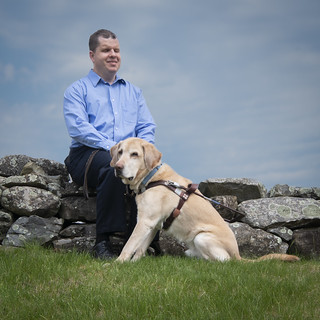 In August I spoke at the LEAD conference
about making coin exhibits accessible. I honestly didn’t know who would benefit from it, but I thought if nothing else, it could be interesting. To my surprise, four organizations reached out for help with their accessible exhibits related to coins, money or numismatics.
In August I spoke at the LEAD conference
about making coin exhibits accessible. I honestly didn’t know who would benefit from it, but I thought if nothing else, it could be interesting. To my surprise, four organizations reached out for help with their accessible exhibits related to coins, money or numismatics.
In October I was invited to the Smithsonian to review their Really Big Money educational program for kids. They had done a great job making it accessible.
I also visited the Bank of Canada museum, which you may know as the Currency Museum, which I visited a few years ago. They asked me to repeat my conference presentation, review their tactile exhibits, and we discussed tactile currency.
While in Canada, I have heard about the Canadian Numismatic Resources. In a way it is similar to the Newman Numismatic Portal, except much smaller in volume, and as I understand there is only very little overlap. So, in case you haven’t heard about it yet, I would highly recommend it.
THE VERMONT POUND THEORY
Website visitor David Carbino writes:
"The pound is the name of an international coin. The pound was a coin used for exchange in different money systems that held value. Vermont soldiers were paid in platinum according to multiple historic references books from VT, Massachusetts, the Smithsonian archives etc.
"The Morris unit was too large for normal business transactions according to George Washington who was a general in the American revolutionary war. John Hanson was the first president of the Continental Congress at the time when VT made its military payments for three years of fighting the British.
 "Coinage was created from european designs to manufacture the first american coinage.A coinage committee was created for that purpose. A U.S. colonel described a Russian platinum coin that was given to American officers during the war when he donated his officer pay to the Smithsonian to create the coin collection. Under donors and donations the Smithsonian and the Chicago Coin Club 1841. National Institute.
"Coinage was created from european designs to manufacture the first american coinage.A coinage committee was created for that purpose. A U.S. colonel described a Russian platinum coin that was given to American officers during the war when he donated his officer pay to the Smithsonian to create the coin collection. Under donors and donations the Smithsonian and the Chicago Coin Club 1841. National Institute.
"A ten thousand dollar transaction in precious metal was valued at 14,400,000 dollars because of a 1440% inflation rate on precious metals. A Spanish silver dollar was the federal unit valued at 1440 continental paper dollars. VT was backed by France, Russia, Spain, Holland as an independent royal colony. VT won the first three battles of the war when George Washington was losing to the British.
"The coin is described in Conant's Vermont 1915. It is also described in Morse's Geography 1804 Boston Massachusetts. A 12 ounce coin with decimal system which was replaced. A federal unit was in platinum and given to the soldiers by the records of the state. I can explain the system of math which includes joes and half joes to read it.
"I know it looks like a Russian medal and I have heard it before. A deception was planned to take this money to back the U.S. when the Continental paper dollar fell 97% in value in 1779. VT produced its coinage in 1781 and delivered in 1782. No dates were required for the coinage before the U.S. Mint in 1792."
DEAL RESCUES STANLEY GIBBONS AND BALDWIN’S
An article in the Antiques Trade Gazette discusses a buy-out for the owner of London-based coin firm Baldwin’s. Here's an excerpt - see the complete article online. -Editor
Stamp and coin dealership group Stanley Gibbons Group has been rescued from administration in a buy-out deal with owner Phoenix Asset Management.
Stanley Gibbons Group, which also owns coin specialist Baldwin’s (AH Baldwin & Sons), will continue to trade as normal and its 66 staff have also been taken on by the new entity, called Strand Collectibles Group.
It is believed that the administration was largely caused by growing debt, following its purchase of a British Guiana 1c Magenta stamp for a hammer price of $7m (£4.97m) or ($8.3m including premium) in 2021. The purchase was funded by debt from Phoenix but a scheme to sell ‘fractional shares’ to investors did not reap the desired amount. Its debt reached £20m and the firm continued to make an annual loss of more than £2m.
VOCABULARY TERM: OXIDATION
Here's another entry from Dick Johnson's Encyclopedia of Coin and Medal Terminology. -Editor
Oxidation. A reaction of a metal surface to certain chemicals, naturally from the environment or artificially induced, which tones or darkens the surface. Also called blackening. The term oxidation comes from the chemical change of iron, where iron oxidizes in the presence of moist air (containing oxygen) to form iron oxide or rust. For bronze, silver and other coin and medal compositions, the term is a misnomer; the actual process is one of sulphatization, where the metal reacts – not with oxygen as does iron – but with sulphur in any of several forms. The process turns the metal a darker color, as dark brown or black. The sulphur can come from any source, as a rubber band (made with sulphur) laid across a silver coin will, in time, form a dark streak of “oxidation.” Such chemical action is a form of toning. See tone, toning.
UPDATE: KKK TOKENS AUTHOR DALE BIRDSELL
E-Sylum Feature Writer and American Numismatic Biographies author Pete Smith submitted this article with a research update on Ku Klux Klan Tokens book author Dale Birdsell. Thank you! -Editor
Mistakes can happen while doing biographical research and I made a big one. As I correct that mistake, I hope to avoid compounding that with new mistakes
 Raymond was born in Frankfort, Kansas, on August 7, 1893. His parents were Frank David
Birdsell (1859-1915) and Carrie E. Ellis Birdsell (1864-1912).
Raymond was born in Frankfort, Kansas, on August 7, 1893. His parents were Frank David
Birdsell (1859-1915) and Carrie E. Ellis Birdsell (1864-1912).
For the 1910 Census, Raymond E., age 16, is living in Oakland, California. with Frank D. and Terry Birdsell. Also in 1910, Raymond F., age 9, is living in Nowata Township, Oklahoma, with Frank A. and Theresa B. Birdsell. The distinction is important as both appear in newspaper articles of the period.
TOM CALDWELL INTERVIEW, PART TWO
Greg Bennick's latest interview for the Newman Numismatic Portal is with Tom Caldwell of Northeast Numismatics. Here's the second of four parts, where Tom discusses the coin business, grading services, and error coins. -Editor
GREG BENNICK: So, one thing that I'm interested in is, and I do want to get into something that you mentioned, I do want to get into security and whatnot and safety and whatnot. Because you brought that up. But one thing I want to mention that's completely different. I grew up in Connecticut, and going to coin shows, Auburn, Massachusetts, Polish National Home, all these shows in the 80s and the early 90s, I was amazed to move out to Washington, where I live now, and find that there's no colonial coins, for example. Whereas if you go to a coin show in the Northeast, there's colonial coins everywhere. And I was really fascinated about the regional nature of coin collecting. Do you encounter, I'm assuming you do, lots of people who are involved with colonial coins? And how much of that market takes up your time? Because out here in Washington, you could go to a coin show and not see even one colonial coin, which amazes me.
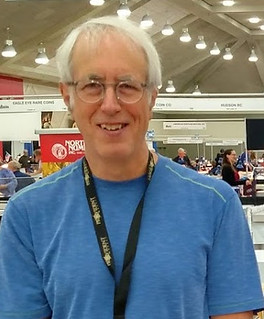 TOM CALDWELL: Well, honestly, I find that a little surprising if you're saying
that's still the case these days with everything. I mean, you can get fresh fruit here
in New England from the West Coast, so coins have been transported around quite
a bit. But I can understand that years ago, because of course, New England was
settled long before Oregon was. But also, it makes some sense just that, I mean,
way back in the day, I was in somebody's attic and they found a hoard of 1853
large cents, which...I got to buy what I wanted. And so that presumably wouldn't
happen out in the Northwest. But I think today, I mean, like we're here in Concord,
there's a Concord Lexington Commem. I think I'm just as lucky to find a Concord
Lexington Commem at a California show as I am here at a Massachusetts show.
Because so many coins have been so distributed everywhere these days. But back
in the day, that's understandable.
TOM CALDWELL: Well, honestly, I find that a little surprising if you're saying
that's still the case these days with everything. I mean, you can get fresh fruit here
in New England from the West Coast, so coins have been transported around quite
a bit. But I can understand that years ago, because of course, New England was
settled long before Oregon was. But also, it makes some sense just that, I mean,
way back in the day, I was in somebody's attic and they found a hoard of 1853
large cents, which...I got to buy what I wanted. And so that presumably wouldn't
happen out in the Northwest. But I think today, I mean, like we're here in Concord,
there's a Concord Lexington Commem. I think I'm just as lucky to find a Concord
Lexington Commem at a California show as I am here at a Massachusetts show.
Because so many coins have been so distributed everywhere these days. But back
in the day, that's understandable.
GREG BENNICK: Yeah. And I think that what maybe has transpired, and I'm just guessing, is that there's people, I know that I'm connected to colonial New England roots, having grown up in Connecticut. But people out here simply are not. So maybe the connection to collecting that has not become as popular here. I mean, I might have overstated that there'd be no colonial coins at a show. There just wouldn't be the preponderance of them that you see at a show, say, in Boston or New Hampshire.
TIBET MUSEUM’S NUMISMATIC EXHIBIT
A Tibet Museum has opened a temporary numismatic exhibition. -Editor
The exhibition, curated by Tenzin Topdhen and Ngawang Dorjee, explores Tibet’s numismatic legacy, unraveling its cultural and historical tapestry through coins and currency. It highlights the evolution of Tibetan currency as a tangible reflection of the region’s diverse influences, providing a unique insight into Tibet’s past. The showcased artefacts include Tibetan coins with distinct designs that symbolise aspects of Tibet’s independence, spirituality, history, and daily life. Additionally, the exhibition delves into the influence of neighbouring cultures, highlighting the region’s interconnections with the broader Asian context.
To enhance the visitor experience, the exhibition fosters a deeper appreciation of Tibet’s currency through interactive displays, multimedia presentations and testimonials. The exhibition not only celebrates the artistic and historical value of Tibet’s currency but also fosters a deeper understanding of Tibet’s diverse cultural identity.
KüNKER SALE 400 HIGHLIGHTS
Künker's auction sale 400 closes February 1st. Here's the press release. Some nice coins. -Editor
Künker’s 400th Auction Sale: A Firework of Numismatics
On 1 February 2024, the World Money Fair kicks off with Künker’s 400th auction. Look forward to a firework of rare coins and medals!
770 lots with a total estimate of more than 7 million euros – do you even need to hear more to get excited about Künker’s 400th auction sale that kicks off the World Money Fair on 1 February 2024? Yes, you do! After all, the Osnabrück auction house will once again offer a selection of exquisite coins and medals that are hardly ever found on the market.
Selected lösers from the Popken Collection
Künker’s auction 400 starts with another part of the Popken Collection. On offer are 39 lösers, including spectacular pieces such as a 1583 Julius löser minted in Wolfenbüttel, or Heinrichstadt as it was called at the time. Another magnificent example from this collection is a 1679 löser of three reichstalers, minted in Zellerfeld on behalf of Prince Rudolph Augustus of Brunswick Wolfenbüttel.
NUMISMATIC NUGGETS: JANUARY 7, 2024
Here's a selection of interesting or unusual items I came across in the marketplace this week. Tell us what you think of some of these. -Editor
Society of Music Friends Medal
Art Nouveau medal by Schafer&Hartig 1912 Society of Music Friends Vienna 7,5 cm
A great medal I hadn't seen before. -Editor
To read the complete lot description, see:
Art Nouveau medal by Schafer&Hartig 1912 Society of Music Friends Vienna 7,5 cm
(https://www.ebay.com/itm/256357867894)
Other topics this week include fanstasy coin copies, replicas and paperweights. -Editor
THE COIN THAT SHOULDN’T EXIST
Mike Markowitz passed along this New York Times article about the scientific examination of an impossible coin. Thanks. Here's an excerpt - see the complete article online. -Editor
A decade ago, a funny money mystery fell into the hands of scientists and students at the Pontifical Catholic University of Peru in Lima.
The university had been acquiring 19th- and 20th-century Peruvian coins from local dealers, and graduate students in the chemistry department were analyzing the pieces for their thesis work. But one coin, a 10-cent piece known as a dinero, stood out.
The dinero was marked “1899.” The problem was that official records indicated no coins of that denomination were minted in Peru that year — according to the people who made the money, the coin never existed.
LINCOLN CENT MULED WITH A ROOSEVELT DIME
Here's another Coin That Shouldn’t Exist - a Lincoln cent muled with a Roosevelt dime reverse, being auctioned by Heritage in their FUN sale this week. Here's the lot description. -Editor
2001-D Lincoln Cent -- Muled With a Roosevelt Dime Reverse -- MS66 Red PCGS. A mule is a coin struck from mismatched dies. In the long history of the U.S. Mint, if patterns are excluded, a total of perhaps 30 mules are known. Best known of all is the circa 2000 "golden" dollar / quarter mule that pairs a Washington state quarter obverse and a Sacagawea dollar reverse on a Sacagawea dollar planchet. About twenty examples of that mule are confirmed, and they regularly command six figures at auction. The state quarter / Sacagawea dollar mule is ranked #1 in the 100 Greatest U.S. Error Coins reference.
Among a multitude of mule possibilities, the Lincoln cent / Roosevelt dime mule is most likely to occur. The diameters for the cent and dime are similar, and both types have annual mintages that often exceed a billion or more pieces. Nonetheless, mules are great rarities. We know of only seven cent / dime mules:
THE BOOK BAZARRE
AUSTRALIA MINTS WORLD'S 1ST COIN IN 2024
Happy New Year, everyone. Before midnight arrived here on the U.S. East Coast, Don Cleveland of Australia passed along a story about the Royal Australian Mint's striking of the first coin in 2024. -Editor
Twelve-year-old Izzy Zaharis (at center) with astrophysicist Brad Tucker of the Australian National University and Mount Stromlo Observatory in Canberra representing the Australian Space Agency (at left) and Royal Australian Mint chief executive officer Leigh Gordan after she won the chance to strike the first coin of 2024, a collectible dollar with the theme "Out of this World - Australia in Space."
HARRIET TUBMAN COMMEMORATIVE COINS
There was a flood of mainstream articles this week about the new commemorative Harriet Tubman coins. Among the first was this National Public Radio piece. -Editor
 Three commemorative coins featuring famed abolitionist and human rights activist Harriet Tubman have now been released to the public, the U.S. Mint said.
Three commemorative coins featuring famed abolitionist and human rights activist Harriet Tubman have now been released to the public, the U.S. Mint said.
The coins, which were released Thursday as part of the Harriet Tubman Commemorative Coin Program, include $5 gold coins, $1 silver coins and half-dollar coins that honor the bicentennial of her birth.
The designs featured on the coins follow the three periods of Tubman's life and her work as an abolitionist and social activist.
TAMPA'S BREADCOIN TOKENS
Charity tokens are nothing new, but the concept seems to get reinvented every generation or two. Tampa, FL is the latest city to adopt "Breadcoin" tokens. Found via News & Notes from the Society of Paper Money Collectors (Volume IX, Number 29, January 2, 2024) -Editor
The Tampa Downtown partnership is working with several restaurants and food trucks to offer those in need with a unique currency to use at select locations. It’s called Breadcoin.
THE INIMITABLE NOTE COMPETITION
A Bank of England museum article by curator Jennifer Adam discusses the famous satirical money art of George Cruikshank and the ensuing ‘Inimitable Note competition’ to make banknotes harder to counterfeit and less tempting to small-time criminals who were being caught and hanged in record numbers. -Editor
At this time, the quality of banknotes was inconsistent. The Bank often re-engraved old, worn printing plates to produce the notes more quickly. More than 700,000 banknotes were issued in the month after the crisis. Forgers took advantage of people’s unfamiliarity with the banknotes and the unreliable quality of notes, and the number of counterfeits surged.
By law, the punishment for counterfeiting or trying to use forged banknotes could be death. Between 1797 and 1817, more than 300 people were sentenced to death for banknote counterfeiting offences.
THE JAMES W. FERRY TRAVEL NOTE
Stack's Bowers Currency Auction Associate Bradley C. Trotter published an article highlighting an interesting annotated dollar bill. -Editor
Paper money isn’t simply a medium of exchange, but also a tangible testament to history. From courtesy autographs of Treasury officials to celebrities to the “Short Snorters” of World War II, paper money can bear witness to history and help to preserve one’s memory.
Although unusual in most respects, this note is not simply an accumulation of signatures collected from strangers, but a detailed listing of travels across Northern Europe.
It is attributed to James W. Ferry, a director of the Commercial Safety Deposit Company of Chicago and president of the City Cab Company. Ferry was a prominent citizen of Chicago in the latter half of the 19th century; he died at the age of 67 in 1897.
CRAFTY COUNTERFEIT DISPLAY, PART ONE
John Regitko of Toronto, Canada submitted this two-part story of his adventure curating a paper money exhibit for the annual Canadian National Exhibition. Here's part one. Previously published in Canadian Coin News, it is republished here with permission. -Editor
ILLEGAL COUNTERFEIT DISPLAY AT SHOW LEADS TO ARREST
One of the exhibits mounted on the wall of the Coin Exhibit at the Arts Crafts Hobbies Building during one of the annual Canadian National Exhibition in Toronto was a display of how paper money was printed by the Canadian Banknote Company and the British American Banknote Company. It covered the printing process of the 1954 series of $1 notes in colour.
I set up the display during the days when the law stated that you could not reproduce banknotes in colour, regardless of the size of the images. (The legislation has changed where you can now legally reproduce images providing it is less than half or more than double actual size.)
Even though tens of thousands of people would view the exhibit, I was not concerned about anyone calling the police accusing me of counterfeiting and/or possession of counterfeit notes.
LOOSE CHANGE: JANUARY 7, 2024
Here are some additional items in the media this week that may be of interest. -Editor
CoinWeek published an article by David Alexander on the rumors and controversies around the Roosevelt Dime. -Editor
 Most circulating United States coins have received their share of negative press when first issued. This includes the beloved Roosevelt dime.
Most circulating United States coins have received their share of negative press when first issued. This includes the beloved Roosevelt dime.
Upon learning of FDR’s death, Mint Director Ross, a fervently loyal Roosevelt appointee, set to work immediately to assure that his portrait would adorn the roster of coins in daily circulation as soon as possible. A commemorative coin would not do, and neither a silver dollar nor gold coins were being issued. That left the half dollar and the dime.
FDR had been closely identified with the nationwide effort to combat the scourge of polio, which was intensifying throughout the country, particularly in major cities during the summers. This author well remembers the annual hysteria in New York City that included sequestering youngsters indoors despite stifling summer heat.
The forceful Ross realized that the Winged Liberty dime had passed its 25th anniversary in 1941 and could be changed without permission of Congress. She gave the go-ahead and the aging Sinnock went to work, propelled by a bill introduced on May 3 by Louisiana Congressman James Hobson Morrison authorizing a Roosevelt portrait. On May 17, Treasury Secretary Henry Morgenthau, Jr. announced that the new dimes would enter circulation close to year’s end.
To read the complete article, see:
The Roosevelt Dime – Stolen Design or Communist Plot?
(https://coinweek.com/roosevelt-dime-stolen-design-communist-plot/)
Other topics this week include a cash-eating dog, gold bars at Costco, and the hot rare book market. -Editor
FEATURED WEBSITE: COIN OF NOTE
This week's Featured Web Site is recommended by Tom Babinszki.
Coin of Note is a personal project to share numismatic information & images of coins or exonumia (tokens, medals / medallions) I enjoy. I love to learn about history & try to include interesting info. I hope you enjoy it! I’m always up for a numismatic chat.
I started Coin of Note back in May 2018 on Twitter. Then I moved to Mastodon, and now I’ve finally setup this site to accompany it.




